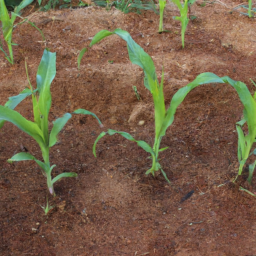How To Grow Corn Small Garden
Table of Contents []
How To Grow Corn In A Small Garden
Soil Selection: How To Grow Corn In A Small Garden
When it comes to growing corn in a small garden, the soil selection is critical for a successful crop. Soil quality and characteristics vary from region to region and from garden to garden. Understanding these factors is essential for harnessing an abundant harvest of cobs. This article looks at top tips for selecting the right soil for growing corn including soil survey data, amendments, and fertilizer.
1. Use Soil Survey Data
When selecting soil for growing corn, it is wise to seek out detailed information, and soil survey data is an excellent source. This information can provide insight into what types of soil are best for growing corn in a particular region. While the soil survey data can be consulted online, it is also wise to consult an expert for a more precise evaluation.
2. Choose a Loamy Soil
Generally speaking, the best soil for corn growing is either sandy loam or loam soil. Loam is made up of a combination of sand, silt, and clay. Each of these components has distinct characteristics and advantages that can contribute positively to the fertility of the soil. A loamy soil tends to have a certain amount of drainage that provides just the right balance of air and water for the plants.
3. Pay Attention To Nutrient Content and pH
In addition to the components of the soil, it is also important to consider the nutrient content and pH of the soil as well. When it comes to corn, the optimum pH for the soil is between 6.0 and 6.8. Additionally, in order to support healthy growth, the soils should contain plenty of nitrogen, potassium, and phosphorus.
4. Consider Fertilizing
If the soil lacks in certain nutrients, you may want to consider adding a fertilizer to the soil. Fertilizers come in a variety of forms and can be added to the soil to help promote the growth of the corn plants. It is also important to consider the timing of this application as the most beneficial time for administering fertilizers is typically towards the end of the season.
5. Use Amendments
Finally, sometimes it is beneficial to supplement the soil with amendments. Animal manure, compost, straw, and mulch can all be added to the soil to help add additional nutrients. Additionally, amendments to the soil can also help with soil texture and aeration.
In Summary
When looking to grow corn in a small garden, it is important to select the right soil. The soil should have the right balance of components and nutrients as well as the appropriate pH level. While soil survey data can be a good source of information, it is also wise to consult an expert. Ultimately, amendments and fertilizers may also be used to supplement the soil and increase the chances of a successful harvest.
Overall, selection of the right soil and proper balance of components can make all the difference in a successful corn harvest. While there is an abundance of information out there, it is important to understand the character of the soil before planting. Ultimately, consulting an expert or utilizing soil survey data can go a long way in helping to choose the right soils for growing corn.

Previous Page
Next Page
